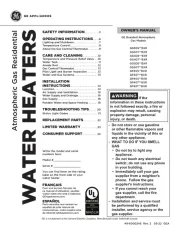Write the model and serial
numbers here:
Model #_________________
Serial # _________________
You can find them on the rating
label on the front side of your
water heater.
GE is a trademark of the General Electric Company. Manufactured under trademark license.
OWNER’S MANUAL
WATER HEATERS
Atmospheric Gas Residential
49-6000245 Rev. 2 05-22 GEA
GE Branded Atmospheric
Gas Models
GG30S**BXR
GG30T**BXR
GG40S**BXR
GG40T**BXR
GG50S**BXR
GG50T**BXR
GP30S**BXR
GP30T**BXR
GP40S**BXR
GP40T**BXR
GP50T**BXR
SAFETY INFORMATION . . . . . . . . . .3
OPERATING INSTRUCTIONS . . . .6
Lighting and Shutdown . . . . . . . . . . . . . . . . .7
Temperature Control . . . . . . . . . . . . . . . . . . .8
About the Gas Control/Thermostat . . . . . . . .9
CARE AND CLEANING . . . . . . . . . .10
Temperature and Pressure Relief Valve . . 10
Water Tank. . . . . . . . . . . . . . . . . . . . . . . . . . . 11
Anode Rod . . . . . . . . . . . . . . . . . . . . . . . . . . 12
Gas Control/Thermostat . . . . . . . . . . . . . . . . 13
Pilot Light and Burner Inspection . . . . . . . 13
Water and Gas Systems . . . . . . . . . . . . . . . . 13
INSTALLATION
INSTRUCTIONS . . . . . . . . . . . . . . . . . . 14
Location . . . . . . . . . . . . . . . . . . . . . . . . . . . . . 14
Air Supply and Ventilation . . . . . . . . . . . . . 15
Water Supply and Drainage . . . . . . . . . . . . . 16
Gas Supply. . . . . . . . . . . . . . . . . . . . . . . . . . . 18
Potable Water and Space Heating . . . . . . 19
TROUBLESHOOTING TIPS . . . . . 20
Status Light Codes . . . . . . . . . . . . . . . . . . . . 21
REPLACEMENT PARTS. . . . . . . . . .22
LIMITED WARRANTY . . . . . . . . . . .23
CONSUMER SUPPORT . . . . . . . . . 24
ESPAÑOL
Para consultar una version en
español de este manual de
instrucciones, visite nuestro sitio
de internet GEAppliances.com.
FRANÇAIS
Pour une version français de
ce manuel d’utilisation, veuillez
visiter notre site web à l’adresse
GEAppliances.com.
WARNING
If the
information in these instructions
is not followed exactly, a fire or
explosion may result, causing
property damage, personal
injury, or death.
- Do not store or use gasoline
or other flammable vapors and
liquids in the vicinity of this or
any other appliance.
- WHAT TO DO IF YOU SMELL
GAS
• Do not try to light any
appliance.
• Do not touch any electrical
switch; do not use any phone
in your building.
• Immediately call your gas
supplier from a neighbor's
phone. Follow the gas
supplier's instructions.
• If you cannot reach your
gas supplier, call the fire
department.
- Installation and service must
be performed by a qualified
installer, service agency or the
gas supplier.




















